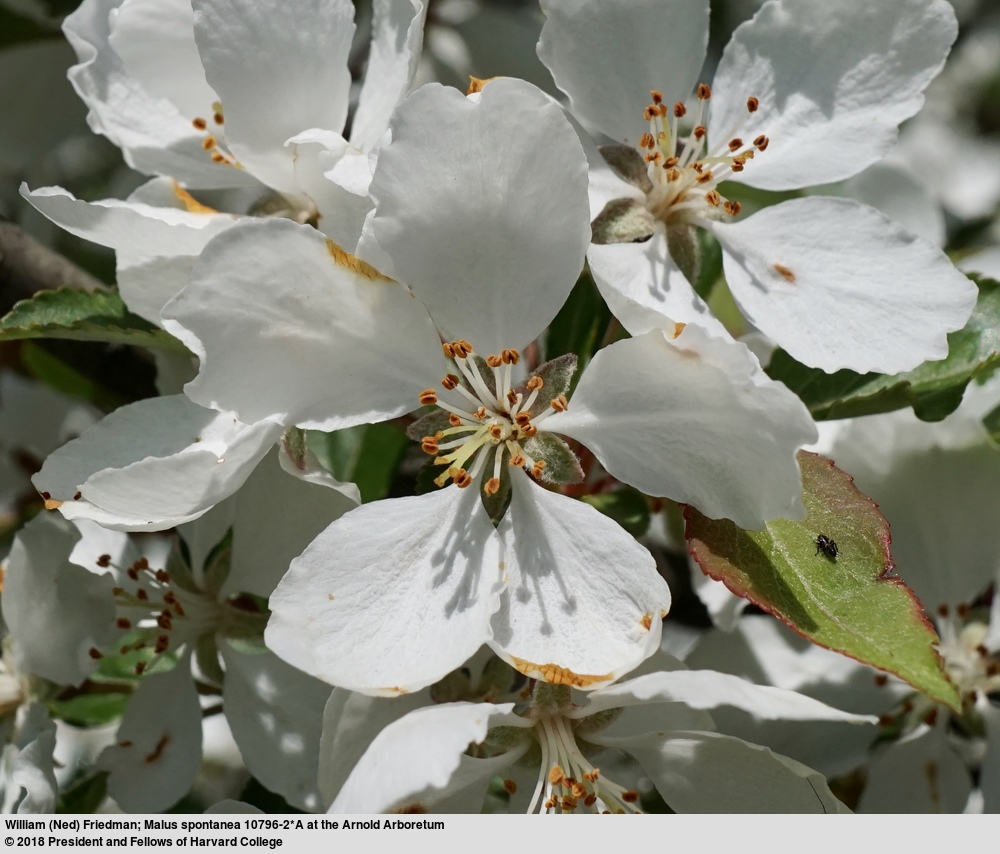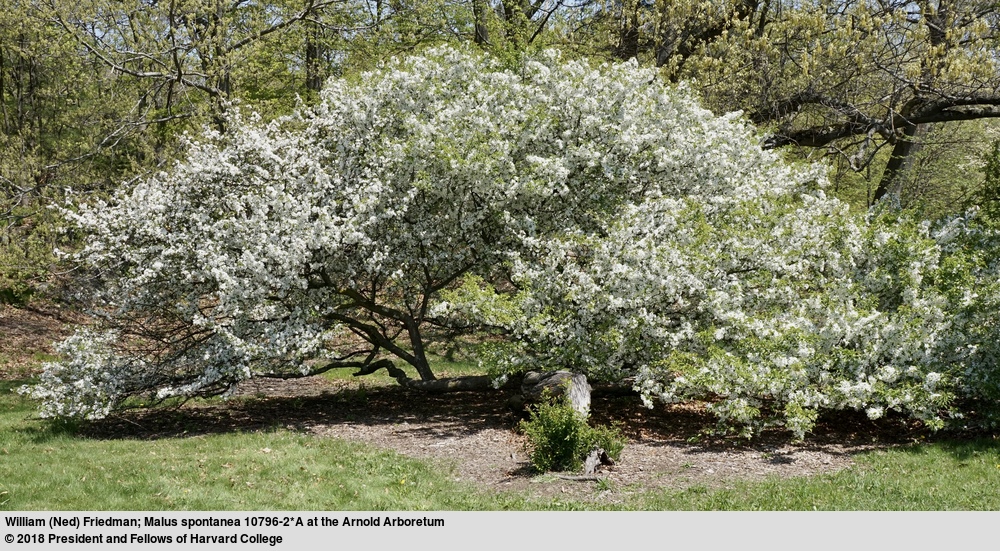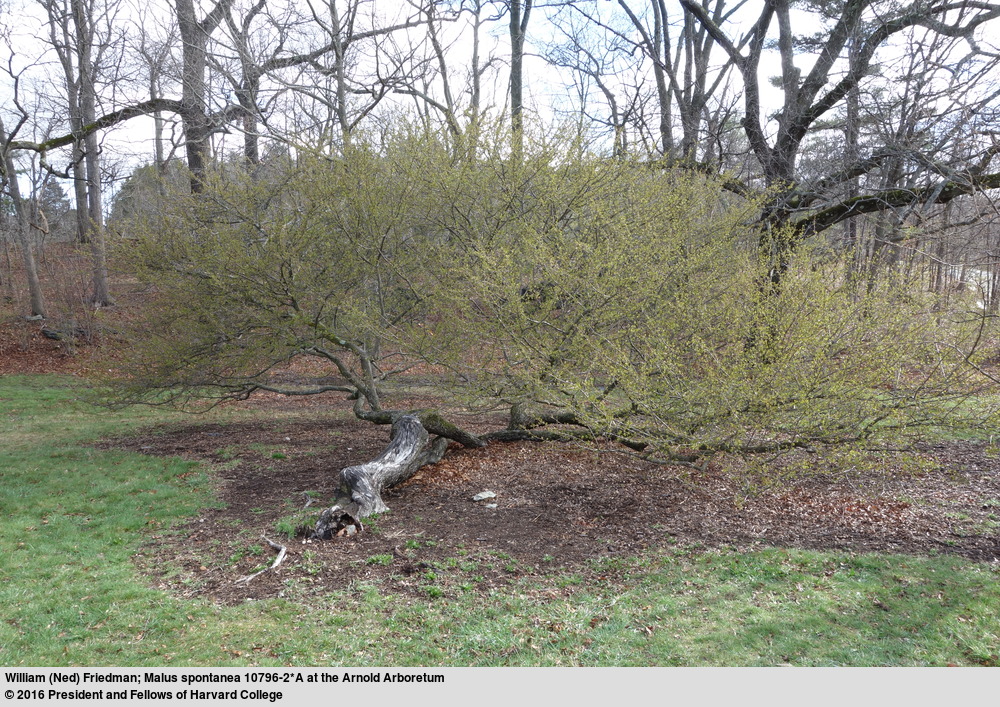Malus spontanea
Sponsor
Kindly sponsored by
Francine: 'after many informative Tours and Study Days with the IDS I feel it only fitting to help and promote such a wonderful organisation'
Credits
Julian Sutton (species), Nick Dunn (cultivars) (2021)
Recommended citation
Sutton, J. & Dunn, N. (2021), 'Malus spontanea' from the website Trees and Shrubs Online (treesandshrubsonline.
Genus
Common Names
- Nokaidou
Synonyms
- Malus halliana var. spontanea (Mak.) Koidz.
- Malus floribunda var. spontanea Mak.
- Sinomalus spontanea (Mak.) Rushforth
Other taxa in genus
- Malus × adstringens
- Malus angustifolia
- Malus × arnoldiana
- Malus asiatica
- Malus × astracanica
- Malus × atrosanguinea
- Malus baccata
- Malus bhutanica
- Malus × brevipes
- Malus chitralensis
- Malus coronaria
- Malus crescimannoi
- Malus Cultivars A-B
- Malus Cultivars C
- Malus Cultivars D-F
- Malus Cultivars G-I
- Malus Cultivars J-K
- Malus Cultivars L-M
- Malus Cultivars N-Q
- Malus Cultivars R
- Malus Cultivars S
- Malus Cultivars T-Z
- Malus dasyphylla
- Malus × dawsoniana
- Malus domestica
- Malus doumeri
- Malus florentina
- Malus × floribunda
- Malus fusca
- Malus × gloriosa
- Malus halliana
- Malus × hartwigii
- Malus × heterophylla
- Malus honanensis
- Malus hupehensis
- Malus ioensis
- Malus kansuensis
- Malus kirghisorum
- Malus komarovii
- Malus × magdeburgensis
- Malus × micromalus
- Malus × moerlandsii
- Malus montana
- Malus ombrophila
- Malus orientalis
- Malus × platycarpa
- Malus praecox
- Malus prattii
- Malus prunifolia
- Malus × purpurea
- Malus × robusta
- Malus rockii
- Malus Rootstock Cultivars
- Malus Rosybloom Cultivars
- Malus × scheideckeri
- Malus sieversii
- Malus sikkimensis
- Malus × soulardii
- Malus spectabilis
- Malus × sublobata
- Malus sylvestris
- Malus toringo
- Malus transitoria
- Malus trilobata
- Malus tschonoskii
- Malus turkmenorum
- Malus yunnanensis
- Malus × zumi
Shrub, typically vase-shaped, or small tree, to 4 m. Leaf blade elliptic to obovate, 3–5 × 1.5–3 cm, glabrous beneath, hairy above when young, base cuneate, apex acute, margins with minute incurved teeth; petiole slender with thin hairs, 1–3 cm. Inflorescence a corymb, pedicels 2–2.5 cm. Flowers 3–3.5 cm diameter in spring; sepals ovate (sometimes narrowly so), glabrous, spreading, falling before fruit is ripe; petals white or almost so; styles 4. Fruit pear shaped, 6–8 mm diameter, fruit reddish or orange. (Ohwi 1965; Bean 1981; Cullen et al. 2011; Iketani & Mase 2013).
Distribution Japan Ebino-kogen Plateau, Kyūshū; local and rare.
Habitat Streamsides, formerly in a marsh; around 1200 m.
USDA Hardiness Zone 6-9
RHS Hardiness Rating H5
Conservation status Not evaluated (NE)
This little known shrub or small tree belongs in the complex around M. baccata, and seems closest to M. halliana, of which it is sometimes considered a variety. It differs from M. halliana in its white or nearly white rather than pink flowers; obovate rather than ovate leaves; and spreading rather than erect sepals (Ohwi 1965). Photographs from the type locality suggest that it would be attractive enough as an ornamental in flower, although the fruits are less than impressive (Ray go 2009). In his original description, Makino (1914) suggested that M. spontanea might have had some part in the mysterious origin of M. × floribunda.
A narrow endemic to the southern Japanese island of Kyūshū, most individuals grow beside a stream within a single 500 m2 area on Mt Kirishima, an active volcano. Numbers had decreased to under 300 by 1998, although conservation measures are now in place (Iketani & Mase 2013) – the species is considered ‘a national treasure’ (H. Iketani in Sax 2011).
Ernest Wilson visited the area in 1919, introducing a living plant to the Arnold Arboretum (Rehder 1926). Several individuals from this lineage grow at the Arnold (Arnold Arboretum 2020). One of these has a bizarre form, upright branches growing from a long, horizontal trunk, perhaps the result of being hit by a stolen car (Sax 2011). Further examples from the Wilson introduction are at the US National Clonal Germplasm Repository, Geneva, NY, and the Holden Arboretum, OH (USDA/ARS, National Genetic Resources Program 2020; Holden Arboretum 2020; Sax 2011); the species is also recorded at the Scott Arboretum, PA (Royal Botanic Garden Edinburgh 2020).
We have been unable to trace any examples of this species in Europe other than young trees at Ness Botanic Gardens, UK, grown from seed of the Wilson trees at the Arnold Arboretum. These proved very uniform and tetraploid, with the exceptions of a weak plant with an irregular chromosome number which soon died, and a larger-fruited tetraploid (H. McAllister pers. comm. 2020). There are, however, diploid chromosome counts in the literature (Schuster & Büttner 1995): it would be premature to suggest that M. spontanea is a tetraploid microspecies.



